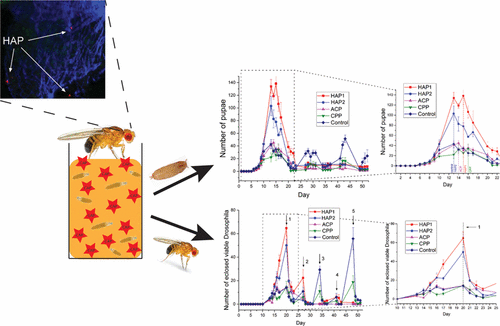当前位置:
X-MOL 学术
›
ACS Biomater. Sci. Eng.
›
论文详情
Our official English website, www.x-mol.net, welcomes your feedback! (Note: you will need to create a separate account there.)
Population Effects of Calcium Phosphate Nanoparticles in Drosophila melanogaster: The Effects of Phase Composition, Crystallinity, and the Pathway of Formation
ACS Biomaterials Science & Engineering ( IF 5.8 ) Pub Date : 2017-09-22 00:00:00 , DOI: 10.1021/acsbiomaterials.7b00540 Victoria M. Wu 1, 2 , Vuk Uskoković 1, 2
ACS Biomaterials Science & Engineering ( IF 5.8 ) Pub Date : 2017-09-22 00:00:00 , DOI: 10.1021/acsbiomaterials.7b00540 Victoria M. Wu 1, 2 , Vuk Uskoković 1, 2
Affiliation

|
Unpredictable biological response due to the finest nanostructural variations is one of the hallmarks of nanoparticles. Because of this erratic behavior of nanoparticles in living systems, thorough analyses of biosafety must precede the analyses of the pharmacotherapeutic efficacy and simple animal models are ideal for such purposes. Drosophila melanogaster, the common fruit fly, is an animal model capable of giving a fast, high-throughput response as to the safety and efficacy of drug delivery carriers and other pharmacological agents, while minimizing the suffering imposed onto animals in more complex in vivo models. Here we studied the effects on the viability and fertility of D. melanogaster due to variations in phase composition, crystallinity, and the pathway of formation of four different calcium phosphate (CP) nanopowders consumed orally. To minimize the effect of other nanostructural variables, CP nanopowders were made to possess highly similar particle sizes and morphologies. The composition of CP affected the fecundity of flies, but so did crystallinity and the pathway of formation. Both the total number of eclosed viable flies and pupae in populations challenged with hydroxyapatite (HAP) greatly exceeded those in control populations. Viability was adversely affected by the only pyrophosphate tested (CPP) and by the metastable and the most active of all CP nanopowders analyzed: the amorphous CP (ACP). The pupation peak was delayed and the viable fly to-pupa ratio increased in all the CP-challenged populations. F1 CPP population, whose viability was most adversely affected by the CP consumption, when crossed, produced the largest number of F2 progeny under regular conditions, possibly pointing to stress as a positive evolutionary drive. The positive effect of HAP on fertility of fruit flies may be due to its slow absorption and the activation of calmodulin during the transit of oocytes through the reproductive tract of fertilized females. Exerted in the prepupation stage, the effect of CP is thus traceable beyond the instar larval stage and to the oogenesis stage of the Drosophila lifecycle.
中文翻译:

果蝇中磷酸钙纳米颗粒的种群效应:相组成,结晶度和形成途径的影响
由于最佳的纳米结构变化而产生的不可预测的生物学响应是纳米颗粒的标志之一。由于纳米粒子在生命系统中的这种不稳定行为,因此在进行药物治疗功效分析之前,必须对生物安全性进行彻底的分析,而简单的动物模型对于此类目的是理想的。黑腹果蝇(Drosophila melanogaster)是一种常见的果蝇,它是一种动物模型,能够对药物输送载体和其他药理剂的安全性和功效做出快速,高通量的响应,同时最大程度地减少了在更复杂的体内模型中对动物造成的痛苦。在这里,我们研究了对D. melanogaster的生存力和繁殖力的影响由于相组成,结晶度以及口服消耗的四种不同磷酸钙(CP)纳米粉的形成途径不同而引起的。为了最小化其他纳米结构变量的影响,制备了CP纳米粉,使其具有高度相似的粒径和形态。CP的组成会影响果蝇的繁殖力,但结晶度和形成途径也会影响果蝇的繁殖力。受羟基磷灰石(HAP)攻击的种群中,封闭的活蝇和p的总数均大大超过了对照种群。生存力受到唯一测试的焦磷酸盐(CPP)以及所分析的所有CP纳米粉中亚稳和最活跃的影响:无定形CP(ACP)。化脓高峰期被延迟,所有受CP挑战的种群中蝇-的存活率均增加。F1个CPP种群在杂交后,其生存能力受到CP消耗的影响最大,在正常条件下产生的F 2后代数量最多,这可能表明压力是一种积极的进化驱动力。HAP对果蝇可育性的积极影响可能是由于它在卵母细胞通过受精雌性生殖道的过程中吸收缓慢以及钙调蛋白的活化所致。因此,在准备阶段发挥作用,CP的作用就可以追溯到果蝇幼虫阶段以外和果蝇生命周期的卵子发生阶段。
更新日期:2017-09-23
中文翻译:

果蝇中磷酸钙纳米颗粒的种群效应:相组成,结晶度和形成途径的影响
由于最佳的纳米结构变化而产生的不可预测的生物学响应是纳米颗粒的标志之一。由于纳米粒子在生命系统中的这种不稳定行为,因此在进行药物治疗功效分析之前,必须对生物安全性进行彻底的分析,而简单的动物模型对于此类目的是理想的。黑腹果蝇(Drosophila melanogaster)是一种常见的果蝇,它是一种动物模型,能够对药物输送载体和其他药理剂的安全性和功效做出快速,高通量的响应,同时最大程度地减少了在更复杂的体内模型中对动物造成的痛苦。在这里,我们研究了对D. melanogaster的生存力和繁殖力的影响由于相组成,结晶度以及口服消耗的四种不同磷酸钙(CP)纳米粉的形成途径不同而引起的。为了最小化其他纳米结构变量的影响,制备了CP纳米粉,使其具有高度相似的粒径和形态。CP的组成会影响果蝇的繁殖力,但结晶度和形成途径也会影响果蝇的繁殖力。受羟基磷灰石(HAP)攻击的种群中,封闭的活蝇和p的总数均大大超过了对照种群。生存力受到唯一测试的焦磷酸盐(CPP)以及所分析的所有CP纳米粉中亚稳和最活跃的影响:无定形CP(ACP)。化脓高峰期被延迟,所有受CP挑战的种群中蝇-的存活率均增加。F1个CPP种群在杂交后,其生存能力受到CP消耗的影响最大,在正常条件下产生的F 2后代数量最多,这可能表明压力是一种积极的进化驱动力。HAP对果蝇可育性的积极影响可能是由于它在卵母细胞通过受精雌性生殖道的过程中吸收缓慢以及钙调蛋白的活化所致。因此,在准备阶段发挥作用,CP的作用就可以追溯到果蝇幼虫阶段以外和果蝇生命周期的卵子发生阶段。


























 京公网安备 11010802027423号
京公网安备 11010802027423号